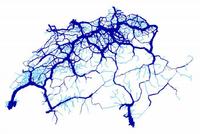|
|||||||||||
Horizons
Leitung
ETH Zürich
Prof. Dr. Kay W. Axhausen
Institut für Verkehrsplanung und Transportsysteme (IVT)
HIL F 31.3
Stefano-Franscini-Platz 5
8093 Zürich
Tel: +41 44 633 39 43
Fax: +41 44 633 10 57


Social Networks and Future Mobilities
IVT Staff
Client
Department of Transport, GB
Partners
Centre for Mobilities Research, Department of Sociology, County College South, Lancaster University
Duration
Keywords
- social networks
- changing spacial patterns
- future mobility
Abstract
This project is concerned with establishing a methodology to examine the impacts that the changing spatial patterns of social networks will have upon future travel. It is expected that over the next couple of decades there will be striking changes in the geographical extent and scale of people's social networks. This so far undocumented process will continue due to historically low prices for long-distance travel and communication and historically high levels of migration and economic interaction between countries (e.g. by investment, trade, service provision)
Most groups intermittently meet up to cement their network, to enjoy each other's company and to carry out certain tasks; these meetings generate travel. Our proposal is for an exploratory project to determine a method for researching the spatial structure of networks and of their meetings, the nature of meetings and the 'need' for travel, which we summarise under the concept of meetingness. We will establish the theoretical frame for understanding such changing networks, carry out intensive interviews to determine an appropriate research method, analyse the provisional results, suggest measures, and develop proposals for a large-scale study.
The policy implication of these changing patterns lies not only in the amount of travel consumed, but also in the changed perception of this travel. Where in the past much of this travel could have been classified as leisure and by implication unnecessary, today it is central to the social cohesion of families, friendship groups, professions and firms.
Methodology
We will explore various ways of researching:
* how many people do respondents 'know'
* are there changes taking place in their sense of 'knowing' other people
* where are those people that they know - are they more far-flung
* how do they keep 'in touch' with them
* how much do they sense an obligation to meet up from time to time
* how do they make new contacts, are they 'networkers'
* how often do they 'meet' up in order to feel that other people are still 'known'
* where do meetings take place and who determines location
* does this cohort have patterns that will continue as they age (grown up with e-communications ready to hand)
* how much does the existence of 'cheap/effective connections', e.g. cheap air tickets, between places make it more difficult to evade meetings
* what ways of providing measures of the patterns allow comparisons between persons or groups at one point in time or over time
We will conduct lengthy face-to-face interviews with a small sample employing people's scheduling tools and mementos that they may use to organise meetings and to document and remember them.
Publications
- Larsen, J., J. Urry and K.W. Axhausen (Forthcoming) Distance connections and face-to-face proxomities, Annals of Tourism Research.
- Larsen, J., K.W. Axhausen and J. Urry (Forthcoming) Geographies of Social Networks: Meetings, Travel and Communications , Mobilities.
- Larsen, J., J. Urry and K.W. Axhausen (2005) Coordinating mobile life, Arbeitsbericht Verkehrs- und Raumplanung, 340, IVT, ETH Zürich, Zürich.
- Larsen, J., J. Urry and K.W. Axhausen (2005) Social networks and future mobilities, report to the Horizons Programme of the Department for Transport, Department of Sociology, University of Lancaster and IVT, ETH Zürich, Lancaster and Zürich
Wichtiger Hinweis:
Diese Website wird in älteren Versionen von Netscape ohne
graphische Elemente dargestellt. Die Funktionalität der
Website ist aber trotzdem gewährleistet. Wenn Sie diese
Website regelmässig benutzen, empfehlen wir Ihnen, auf
Ihrem Computer einen aktuellen Browser zu installieren. Weitere
Informationen finden Sie auf
folgender
Seite.
Important Note:
The content in this site is accessible to any browser or
Internet device, however, some graphics will display correctly
only in the newer versions of Netscape. To get the most out of
our site we suggest you upgrade to a newer browser.
More
information

